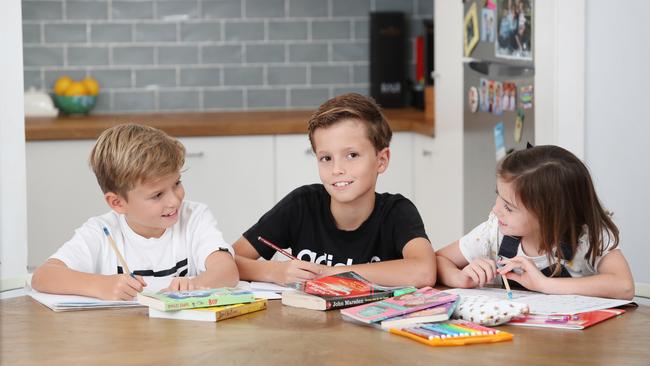Homeschooling coronavirus: How to teach your kids English during lockdown
If you are nervous about homeschooling resuming for term two this week, we have some helpful tips on how to navigate being an English teacher for every grade.

- Blueprint for NSW schools’ classroom return
- Carrying books, not virus at school
- Ask The Expert: Going back to school
This week sees the return of online and distance learning across NSW as parents are asked to assist teachers to educate their children at home during a staggered return to classrooms.
It’s a daunting task for most parents, who will also be juggling working from home at the same time.
Anxiety over how to help your child, understanding what they are learning and why they are
learning it will become a real pain point for mums and dads.
Today, the Kids News’ Learning At Home program has partnered with Evidence For
Learning to analyse a key English teaching technique in four age categories to assist parents
in understanding what their children are learning.

Parents should remember that they are not expected to have the expertise of a teacher during
this home learning period and teachers will determine what material needs to be learned at
home.
Parents should encourage their children to communicate openly with their teachers and tell
them if they have any concerns or issues about what they are learning or if they are having
difficulty.
Kindergarten to Yr 2: SHARED READING
What is it?
Shared reading is when a teacher or parent reads to, or with, a child or children. Big books
with enlarged text and illustrations are traditionally used so children can follow the words as
the adult reads. Initially the teacher or parent may do much of the reading. However, as
children become more familiar with the text they will assume more control, particularly at
repetitive sections or when rhyme and rhythm are present.
Why is my child learning this?
A focus on reading during home-based learning will help lessen learning declines associated
with not being in a formal school setting. It also builds confidence in reading, expands
vocabulary, promotes pleasure from text and demonstrates concepts of print such as reading
left to right and top to bottom.

Common mistakes
1. Not reading to a child every night to develop a love of reading and routine.
2. Assuming children will learn to read at school so there is no need to read at home.
3. Parents doing all of the reading and children just listening without interaction.
Tips for parents
1. Review any book suggestions and shared reading tips provided by your child’s school.
Choose a book with large text and illustrations and make sure your child can see each page as
you read.
2. As you read, ask your child prompting questions, such as ‘What do you think will happen
next?’ or ‘Do you think he/she can solve the problem?’
3. Ask your child if anything in their own life reminds them of what happened in the story?
Was the character loved by his/her family? Did they work as a team?
4. After reading, ask the 5 Ws about the book – who was it about, what was it about, where
was the book set, when did something happen and why did something happen?
5. Parents should use a mixture of closed questions (which can be answered with a single
word) and open questions (which require a fuller response). Your child’s school may provide
example questions to use for certain books.
6. When you decide to stop reading, ask your child to summarise what has happened in the
book or story so far.
7. Encourage them to sound out words and show them how to break down big words into
smaller sounds.
8. Paraphrase a child’s talk to model more complex language e.g. Child: “I see a bird”,
response: “Yes, I can see the Rosella. It reminds me of a colourful rainbow.”
YEARS 3-4: NARRATIVES
What is it?
A narrative is a story of events or experiences that are real or imagined.
Why is my child learning this?
Narrative writing allows children to express their stories creatively, to help clarify their
thinking, and to teach them to express that in writing in an organised way.
Common mistakes
1. Assuming story ideas come easily to children because they have vivid imaginations.
2. Assuming children will visualise a start, middle and ending to their stories.
3. Believing children can automatically articulate what they are picturing in their minds into
words.

Tips for Parents
1. Review any writing task instructions provided by your child’s school. Discuss the topic
your child has chosen to write about. What do they know about it? What interests them about
it?
2. Have your child brainstorm ideas they could write about that topic. Ask them to come up
with 10 ideas. The first few are likely to be common themes most children will think of, but
the last ideas will be unique.
3. Now have your child write down associated words, thoughts and ideas around their central
idea. Make sure they include descriptive words such as adjectives and adverbs.
4. Ask your child to think about the ending before starting to write the narrative so they have
an idea of where the story is going
5. Depending on any writing instructions provided your child’s school, you could ask your
child to incorporate these key elements into their story:
a. Setting the scene
b. Introducing and describing the characters
c Developing the plot and introducing other characters
d. Posing a conflict or problem for a character
e. A climax when the problem is realised and the suspense is high
f. A resolution when the problem is solved and a satisfactory ending is reached.
YEARS 5-6: PERSUASIVE TEXT
What is it?
A piece of writing aimed at persuading and influencing how an audience thinks about a topic.
Why does my child learn this?
To learn to analyse texts critically in order to determine the messages and assumptions being
expressed and to recognise the grammatical and/or visual techniques and language choices
that have been selected to convey the intended meaning.
Common mistakes:
Writing without an audience in mind.
The writer puts themselves into the argument with phrases such as ‘I believe’ and ‘I think’.
Ignoring or being dismissive of other viewpoints.

Tips for parents
1. Review any writing task instructions provided by your child’s school. Have your child
write a series of ideas on their topic to plan what they will write about.
2. Encourage your child to use facts and examples to convince the reader of their argument.
Tell them to leave their “own” opinion out of the writing. Avoid phrases such as ‘In my
opinion’, or ‘I believe’.
3. Explain to your child that they don’t need to avoid an opposing view or argument. When
mentioning them, children could use phrases such as “while this is understandable” or “while
there is some truth to this” to show they have examined both sides of the issue and have gone
to the trouble of trying to put themselves in the shoes of the people who disagree with them.
4. Make sure your child checks and edits the writing so it is clear for a reader.
5. Help review the writing for your child. Check that it starts with an introduction outlining
the topic or argument, uses paragraphs to organise the ideas and write the body of the text in
full sentences, and finishes with a conclusion that sums up the points of their argument. Pay
attention to spelling and punctuation.
6. Check whether they need to submit the writing task to their teacher.
YEARS 7-12: BREAKING DOWN COMPLEX TEXTS
What is it?
The ability to decode, use, interact with, analyse and evaluate texts to build understanding
and meaning.
Why does my child learn this?
To allow them to confidently engage with, and think critically about, all manner of complex
texts they are likely to interact with in school and later in life.
Common mistakes
Skimming the text too quickly and not stopping to think what the meaning could be.
Not breaking the text down into chunks of information for easier processing.
Not visualising what is being conveyed in the text.

Tips for Parents
1. Understand the purpose for reading the text.
Review any instructions provided by your child’s school. Is the purpose of reading the text to
understand someone’s perspective, is it to discover a problem?
2. Activate prior knowledge before reading the text.
Have the child think about what they already know about the topic from reading or other
experiences, such as visits to museums, and try to make meaningful links. This helps children
to infer and elaborate, fill in missing information and to build a fuller ‘mental model’ of the
text.
3. Break the text down into important chunks of information.
Encourage your child to break down the text so that a long text will not seem so
overwhelming.
4. Highlight and underline.
Suggest that your child to mark important passages and quotes, annotate sentences and
sections that are significant, and underline keywords or other words they don’t understand.
This helps highlight the key points to the text.
5. Read difficult sections again.
Encourage children to read hard-to-understand sections multiple times to gain the meaning. If
they are still unsure, encourage them to research it to see if they can find clarification.
6. Read aloud
Suggest that your child read aloud to help to slow their reading and allow them to consider
every word and its meaning.
7. Use prediction
Have the child predict what might happen as a text is read. This causes them to pay close
attention to the text, which means they can closely monitor their own comprehension.
8. Ask your own questions
Ask the child to form 3 or more questions about the text to check their comprehension and
monitor their subject knowledge.
9. Summarise it
Ask the child to give a summary of the meaning of sections of the text. This causes children
to focus on the key content, which in turn supports comprehension. This can be enhanced by
using graphics that illustrate concepts.
* Evidence for Learning is a non-profit, independent national organisation whose mission is
to help educators increase learning through better research. Kidsnews.com.au, a free
educational news literacy site, is partnering with Evidence for Learning to make sure the
advice and suggestions given to parents to support learning at home is informed by the best
available evidence.
